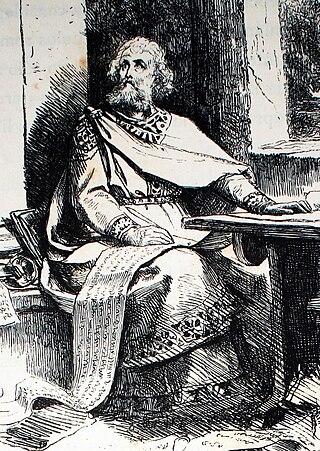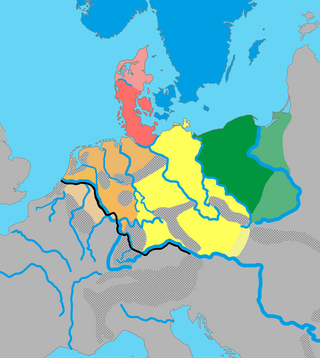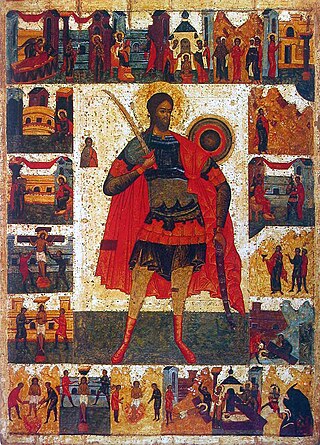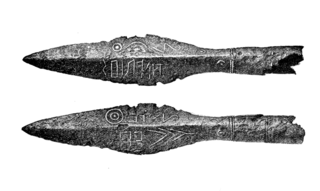
Ulfilas, known also as Wulfilas or Urphilas, was a 4th century Gothic preacher of Cappadocian Greek descent. He was the apostle to the Gothic people and the father of Germanic literature.
Vandalic was the Germanic language spoken by the Vandals during roughly the 3rd to 6th centuries. It was probably closely related to Gothic, and, as such, is traditionally classified as an East Germanic language. Its attestation is very fragmentary, mainly due to the Vandals' constant migrations and late adoption of writing. All modern sources from the time when Vandalic was spoken are protohistoric.

The Codex Argenteus is a 6th-century illuminated manuscript, originally containing part of the 4th-century translation of the Christian Bible into the Gothic language. Traditionally ascribed to the Arian bishop Wulfila, it is now established that the Gothic translation was performed by several scholars, possibly under Wulfila's supervision. Of the original 336 folios, 188—including the Speyer fragment discovered in 1970—have been preserved, containing the translation of the greater part of the four canonical gospels. A part of it is on permanent display at the Carolina Rediviva building in Uppsala, Sweden, under the name "Silverbibeln".

The Bible has been translated into many languages from the biblical languages of Hebrew, Aramaic, and Greek. As of September 2023 all of the Bible has been translated into 736 languages, the New Testament has been translated into an additional 1,658 languages, and smaller portions of the Bible have been translated into 1,264 other languages according to Wycliffe Global Alliance. Thus, at least some portions of the Bible have been translated into 3,658 languages.

The Skeireins is the second-longest known surviving text in the Gothic language, after Ulfilas' version of the Bible. It consists of eight fragments of a commentary on the Gospel of John which is commonly held to have originally extended over seventy-eight parchment leaves. It owes its title to the 19th-century German scholar Hans Ferdinand Massmann, who was the first to issue a comprehensive and correct edition of it: "Skeireins" means "explanation" in Gothic. The manuscript containing the Skeireins text is a palimpsest.

The East Germanic languages, also called the Oder-Vistula Germanic languages, are a group of extinct Germanic languages that were spoken by East Germanic peoples. East Germanic is one of the primary branches of Germanic languages, along with North Germanic and West Germanic.

The Gothic alphabet is an alphabet used for writing the Gothic language. Ulfilas developed it in the 4th century AD for the purpose of translating the Bible.

Codex Claromontanus, symbolized by Dp, D2 or 06 (in the Gregory-Aland numbering), δ 1026 (von Soden), is a Greek-Latin diglot uncial manuscript of the New Testament, written in an uncial hand on vellum. The Greek and Latin texts are on facing pages, thus it is a "diglot" manuscript, like Codex Bezae Cantabrigiensis. The Latin text is designated by d (traditional system) or by 75 in Beuron system.
Gothic Christianity refers to the Christian religion of the Goths and sometimes the Gepids, Vandals, and Burgundians, who may have used the translation of the Bible into the Gothic language and shared common doctrines and practices.

There have been many Coptic versions of the Bible, including some of the earliest translations into any language. Several different versions were made in the ancient world, with different editions of the Old and New Testament in five of the dialects of Coptic: Bohairic (northern), Fayyumic, Sahidic (southern), Akhmimic and Mesokemic (middle). Biblical books were translated from the Alexandrian Greek version.

The Codices Ambrosiani A–E are five biblical manuscripts dating to the 6th–11th centuries CE now in the Biblioteca Ambrosiana in Milan. They are written by different hands and in different alphabets. The codices contain scattered passages from the Old Testament (Nehemiah) and the New Testament, as well as some commentaries known as Skeireins, rare survivals in the Gothic language.

Gothic is an extinct East Germanic language that was spoken by the Goths. It is known primarily from the Codex Argenteus, a 6th-century copy of a 4th-century Bible translation, and is the only East Germanic language with a sizeable text corpus. All others, including Burgundian and Vandalic, are known, if at all, only from proper names that survived in historical accounts, and from loanwords in other languages such as Portuguese, Spanish, Catalan, Occitan, and French.

Syriac is a dialect of Aramaic. Portions of the Old Testament were written in Aramaic and there are Aramaic phrases in the New Testament. Syriac translations of the New Testament were among the first and date from the 2nd century. The whole Bible was translated by the 5th century. Besides Syriac, there are Bible translations into other Aramaic dialects.

Codex Carolinus is an uncial manuscript of the New Testament on parchment, dated to the 6th or 7th century. It is a palimpsest containing a Latin text written over a Gothic one. The Gothic text is designated by siglum Car, the Latin text is designated by siglum gue or by 79, it represents the Old Latin translation of the New Testament. It is housed in the Herzog August Library in Wolfenbüttel in Lower Saxony, Germany.
Carla Falluomini is an Italian philologist who specializes on Gothic and Lombardic palaeography, languages and cultures. She is currently professor at the University of Perugia.

The Euthalian Apparatus is a collection of additional editorial material, such as divisions of text, lists, and summaries, to the New Testament's Book of Acts, Catholic epistles, and Pauline epistles. This additional material appears at the beginnings of books, in the margin of the text, and at the ends of books, as well as in line and paragraph separations. This material is traditionally associated with the name of Euthalius.
The Codex Floriacensis, designated by h in traditional system or by 55 in the Beuron system, is a 6th-century Latin manuscript of the New Testament. The text, written on vellum, is a palimpsest. Another name of the manuscript is Fleury Palimpsest or Palimpsestus Floriacensis. It is one of the eight Old-Latin manuscripts with text of Apocalypse.

There is a record of Gothic persecution of Christians in the third century. According to Basil of Caesarea, some prisoners taken captive in a Gothic raid on Cappadocia around 260 preached the gospel to their captors and were martyred. One of their names was Eutychus. Bishop Dionysius of Caesarea sent messengers to the Goths to ransom captives and there was still a written record of these attempts in Basil's time.

Gothic paganism was the original religion of the Goths before their conversion to Christianity.

The Codex Gissensis was a fragmentary parchment manuscript, a Gothic–Latin diglot containing texts of the Bible in Gothic on the left and Latin on the right.

















